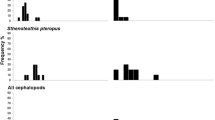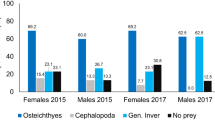Abstract
To understand the year-round ecology of seabirds it is necessary not only to study the birds in their breeding grounds, but also to gain information about their movements during the inter-breeding period. Especially for the smaller procellariiform species, such studies are still scarce, mainly due to methodological problems. The recovery rates of banded birds are low and satellite tracking devices still far too heavy to equip these small birds. Here, we present data on foraging areas of Wilson’s storm-petrel Oceanites oceanicus inferred from stable isotope analysis. We compared ratios of δ13C and δ15N between different life-history stages and between the breeding and inter-breeding period. Samples of adult and chick feathers, chick down and egg-white were taken between 1996 and 2005 on King-George-Island, South Shetland Islands. δ13C values can be clearly distinguished between the breeding and inter-breeding period. During the inter-breeding period, most pre-breeders foraged in the same area as breeders, but four pre-breeders were found to forage in latitudes north of the Subtropical Front. In the 2002 inter-breeding period adult birds wintered further north than in 2003, which is in line with the different locations of food rich frontal systems in these years. We show that isotope ratios of both δ13C and δ15N increase from egg white, over chick down to chick feathers. We suggest that this isotopic change, due to a change in both foraging location and diet between egg production and chick feeding, may be used to trace the shift from the use of maternal resources from the egg to the uptake of nutrients from the diet.




Similar content being viewed by others
References
Ash J (1982) Wilson’s petrels oceanites oceanicus off Somalia. Scopus 6
Bearhop S, Furness RW, Hilton GM, Votier SC, Waldron S (2003) A forensic approach to understanding diet and habitat use from stable isotope analysis of (avian) claw material. Funct Ecol 17:270–275
Beck JR, Brown DW (1972) The biology of Wilson’s Storm petrel, Oceanites oceanicus (Kuhl), at Signy Island, South Orkney Islands. Br Antarct Surv Sci Rep 69:1–54
Boersma PD, Stokes DL, Strange IJ (2002) Applying ecology to conservation: tracking breeding penguins at New Island South Reserve, Falkland Islands. Aquat Conserv Mar Freshw Ecosyst 12:63–74
Bost CA, Charrassin JB, Clerquin Y, Ropert-Coudert Y, Le Maho Y (2004) Exploitation of distant marginal ice zones by king penguins during winter. Mar Ecol Prog Ser 283:293–297
Britton P (1981) Wilson’s storm petrel Oceanites oceanicus in Kenya. Scopus 5
Cherel Y, Hobson KA, Weimerskirch H (2000) Using stable-isotope analysis of feathers to distinguish moulting and breeding origins of seabirds. Oecologia 122:155–162
Cherel Y, Hobson KA, Weimerskirch H (2005) Using stable isotopes to study resource acquisition and allocation in procellariiform seabirds. Oecologia 145:533–540
Clarke J, Kerry K, Fowler C, Lawless R, Eberhard S, Murphy R (2003) Post-fledging and winter migration of Adelie penguins Pygoscelis adeliae in the Mawson region of East Antarctica. Mar Ecol Prog Ser 248:267–278
Croxall JP, Prince PA (1980) Food, feeding ecology and ecological segregation of seabirds at South Georgia. Biol J Linn Soc 14:103–131
Flood B, Fisher A (2005) Wilson’s petrels off the Isles of Scilly: a five year analysis, 2000–2004. Birding World 18
Forero MG, Gonzalez-Solis J, Hobson KA, Doncazar JA, Bertellotti M, Blanco G, Bortolotti GR (2005) Stable isotopes reveal trophic segregation by sex and age in the southern giant petrel in two different food webs. Mar Ecol Prog Ser 296:107–113
Hahn S, Peter HU, Quillfeldt P, Reinhardt K (1998) The birds of the Potter Peninsula, King George Island, South Shetland Islands, Antarctica, 1965–1998. Mar Ornithol 26:1–6
Hobson KA (1999) Tracing origins and migration of wildlife using stable isotopes: a review. Oecologia 120:314–326
Hobson KA, McLellan BN, Woods JG (2000) Using stable carbon (delta C-13) and nitrogen (delta N-15) isotopes to infer trophic relationships among black and grizzly bears in the upper Columbia River basin, British Columbia. Can J Zool Rev Can Zool 78:1332–1339
Hobson KA, Welch HE (1992) Determination of Trophic relationships within a high Arctic marine food web using Delta-C-13 and Delta-N-15 analysis. Mar Ecol Prog Ser 84:9–18
Hodum PJ, Hobson KA (2000) Trophic relationships among Antarctic fulmarine petrels: insights into dietary overlap and chick provisioning strategies inferred from stable-isotope (delta N-15 and delta C-13) analyses. Mar Ecol Prog Ser 198:273–281
Kitching M (2002) The Wilson’s petrel off Northumberland - the first British North Sea record. Birding World 15:390–391
Klaassen M, Baarspul T, Dekkers T, van Tienen P (2004) The relationship between carbon stable isotope ratios of hatchling down and egg yolk in Black-headed Gulls. J Field Ornithol 75:196–199
Minagawa M, Wada E (1984) Stepwise enrichment of N-15 along food-chains—further evidence and the relation between Delta-N-15 and animal age. Geochim Cosmochim Acta 48:1135–1140
Nakamura K, Tanaka Y, Hasegawa M (1983) Distribution status of the Wilson’s storm-petrel Oceanites oceanicus in Japanese waters. Bull Biogeograph Soc Jap 38
Nicholls DG, Robertson CJR, Prince PA, Murray MD, Walker KJ, Elliott GP (2002) Foraging niches of three Diomedea albatrosses. Mar Ecol Prog Ser 231:269–277
Owens NJP (1987) Natural variations in N-15 in the marine-environment. Adv Mar Biol 24:389–451
Pennycuick CJ, Croxall JP, Prince PA (1984) Scaling of foraging radius and growth-rate in petrels and albatrosses (Procellariiformes). Ornis Scand 15:145–154
Priddle J, Croxall JP, Everson I, Heywood RB, Murphy EJ, Prince PA, Sear CB (1988) Large-scale fluctuations in distribution and abundance of krill—a discussion of possible causes. In: Sahrhage D (ed) Antarctic Ocean and resources variability. Springer, Berlin, pp 169–182
Quillfeldt P (2001) Variation in breeding success in Wilson’s storm petrels: influence of environmental factors. Antarct Sci 13:400–409
Quillfeldt P (2002) Seasonal and annual variation in the diet of breeding and non-breeding Wilson’s storm-petrels on King George Island, South Shetland Islands. Polar Biol 25:216–221
Quillfeldt P, McGill RAR, Furness RW (2005) Diet and foraging areas of Southern Ocean seabirds and their prey inferred from stable isotopes: review and case study of Wilson’s storm-petrel. Mar Ecol Prog Ser 295:295–304
Quillfeldt P, Schmoll T, Peter HU (2000) The use of foot web coloration for the estimation of prebreeder numbers in Wilson’s storm-petrels, Oceanites oceanicus. Polar Biol 23:802–804
Quillfeldt P, Strange IJ, Masello JF (2006) Sea surface temperatures and behavioral buffering capacity in Thin-billed prions: breeding success, provisioning and chick begging. J Avian Biol (in press)
Roberts B (1940) The life cycle of Wilson’s Petrel Oceanites oceanicus (Kuhl). Br Graham Land Expedition Sci Rep 1:141–194
Romanoff AL, Romanoff AJ (1949) The avian egg. Wiley, New York
Rubenstein DR, Hobson KA (2004) From birds to butterflies: animal movement patterns and stable isotopes. Trends Ecol Evol 19:256–263
Schmidt K, Atkinson A, Stubing D, McClelland JW, Montoya JP, Voss M (2003) Trophic relationships among Southern Ocean copepods and krill: some uses and limitations of a stable isotope approach. Limnol Oceanogr 48:277–289
Schmidt K, McClelland JW, Mente E, Montoya JP, Atkinson A, Voss M (2004) Trophic-level interpretation based on delta N-15 values: implications of tissue-specific fractionation and amino acid composition. Mar Ecol Prog Ser 266:43–58
Siegel V (1986) Untersuchungen zur Biologie des Antarktischen Krill Euphausia superba, im Bereich der Bransfield Strasse und angrenzender Gebiete. Mitt Inst Seefisch Hamb 38:1–244
Trivelpiece SG, Trivelpiece wZ (1998) Post-fledging dispersal of Southern Giant Petrels Macronectes giganteus banded at Admiralty Bay, King George Island, Antarctica. Mar Ornithol 26:63–68
Warham J (1990) The petrels—their ecology and breeding systems. Academic, London
Weimerskirch H, Le Corre M, Jaquemet S, Potier M, Marsac F (2004) Foraging strategy of a top predator in tropical waters: great frigatebirds in the Mozambique Channel. Mar Ecol Prog Ser 275:297–308
Acknowledgments
We like to thank Anja Nordt for contributing feather and down samples and David Gladbach for his extensive help in the laboratory. NERC funded the isotope facility. We also thank Hans-Ulrich Peter for organizing the logistics of the fieldwork over the years. We received logistic support from the Alfred-Wegner Institute of Marine and Polar Research (Bremerhaven, Germany), the National Antarctic Institute of Argentina and Hapag Lloyd Seetouristik GmbH. Peter Hodum and two anonymous referees provided helpful comments on the manuscript. This study was partly funded by a grant provided by Deutsche Forschungsgemeinschaft to PQ (Qu148).
Author information
Authors and Affiliations
Corresponding author
Rights and permissions
About this article
Cite this article
Gladbach, A., McGill, R.A.R. & Quillfeldt, P. Foraging areas of Wilson’s storm-petrel Oceanites oceanicus in the breeding and inter-breeding period determined by stable isotope analysis. Polar Biol 30, 1005–1012 (2007). https://doi.org/10.1007/s00300-007-0258-2
Received:
Revised:
Accepted:
Published:
Issue Date:
DOI: https://doi.org/10.1007/s00300-007-0258-2




